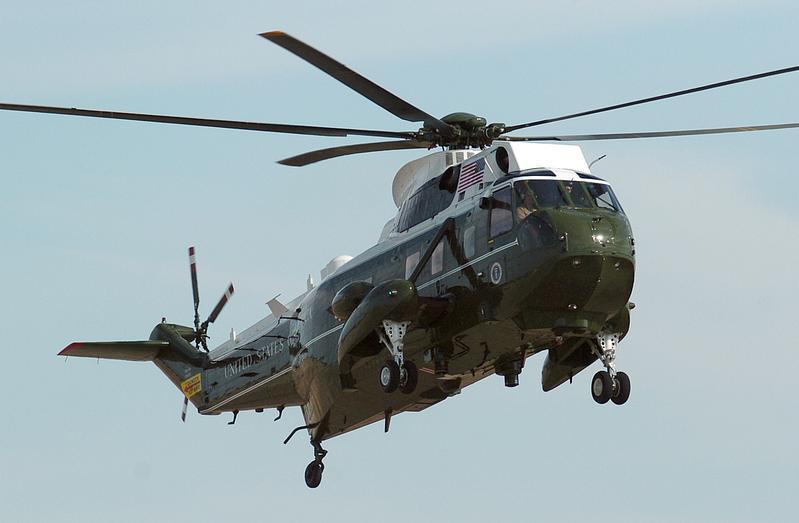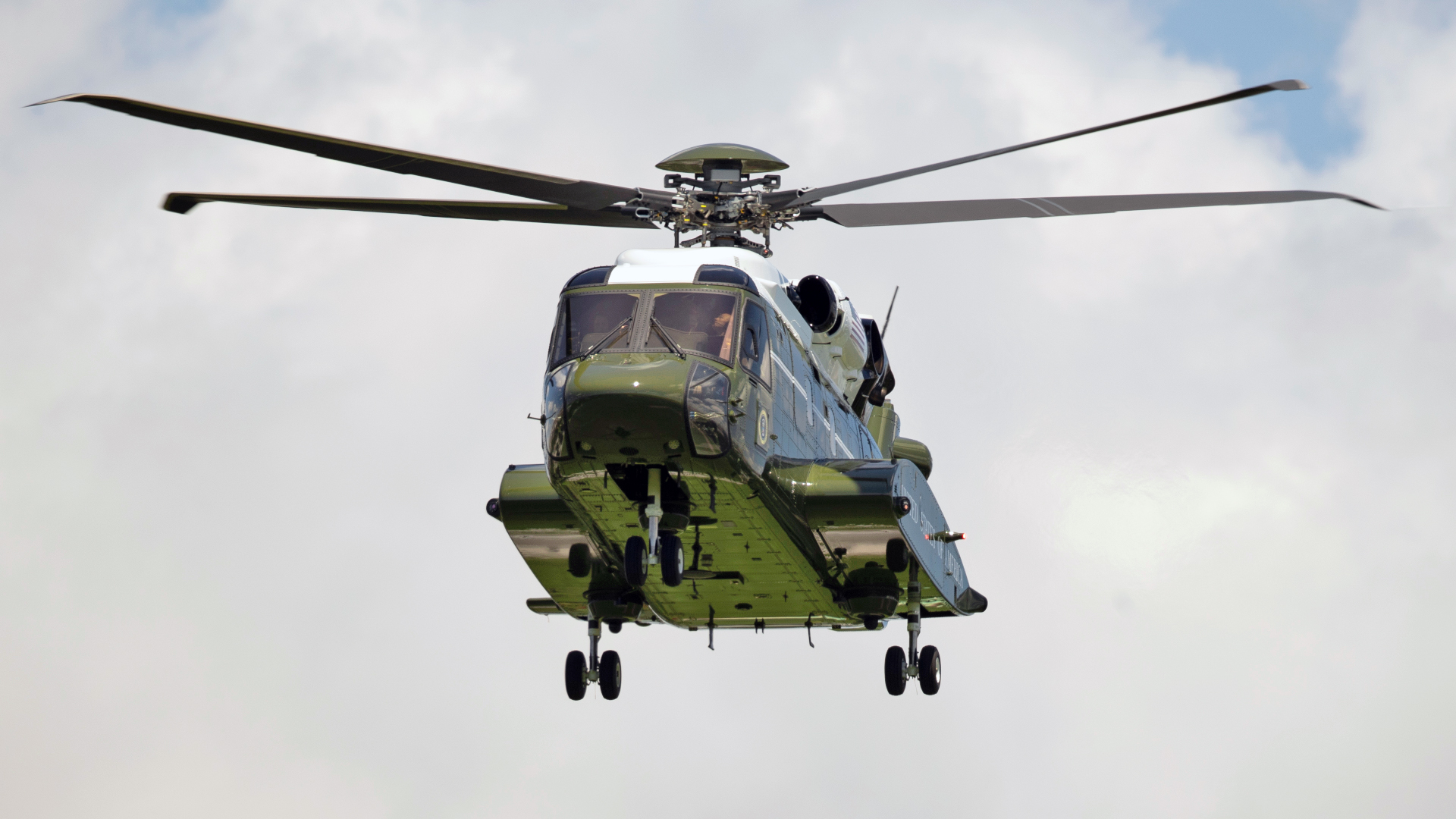The U.S. Marine Corps deployed one of its new VH-92A Patriot presidential helicopters to Las Vegas ahead of President Joe Biden’s expected visit there today. However, the VH-92A still isn’t approved for regular use in the “Marine One” presidential airlift role, largely due to lingering concerns about its critical secure communications suite. So, the one now in Las Vegas is there only in a “standby capacity.”
Pictures of a VH-92A flying in the Las Vegas area first emerged on social media this past weekend. It’s not immediately clear how many VH-92As the Marines have in total, but the plan has long been that the total fleet of 23 (two of which would be set aside for testing) would be delivered by 2023.
“Marine Helicopter Squadron One (HMX-1) recently deployed one VH-92A to Las Vegas in a standby capacity,” Marine Corps aviation spokesperson Maj. Jay Hernandez told The War Zone. “The VH-92A will not be used as a primary helicopter lift platform until a later phase in the transition.”
HMX-1 operates the Marine Corps’ fleet of “white top” presidential helicopters, which also currently includes VH-3D and VH-60N types, which the VH-92 is intended to replace. These helicopters, which are used to shuttle the President, their family, and closest advisors around at home and abroad, are commonly referred to as Marine Ones. However, that callsign is only technically used when the President is onboard.
Hernandez confirmed that the President has not flown in a VH-92A yet.
“The Marine Corps continues to work with the White House Military Office, [the Naval Air Systems Command’s] Presidential Helicopters Program Office (PMA-274), and Marine Helicopter Squadron One (HMX-1) to ensure the conditions are set for a successful transition from the current in-service VH-3D and VH-60 aircraft to the VH-92A,” Hernandez stated. “This is an event-driven goal, not a time-driven one.”

“VH-92A tasking for presidential support will be at the discretion of the White House Military Office,” the Marine spokesperson continued. “The VH-92A remains within budgeted cost and schedule as approved by Congress.”
The Marines officially declared they had reached initial operational capability with the type in April 2022, but this came with important caveats. Continuing issues with the VH-92A’s Mission Communication System (MCS) have been a major factor holding back the helicopter from being used in the Marine One role, as you can read more about here. It is also unclear if the matter of its engine exhaust scorching the White House lawn has been completely resolved, though this would not necessarily be an issue for deployments elsewhere like Las Vegas.
With all this in mind, how exactly the Marines may be prepared to use the ‘standby’ VH-92A in Las Vegas is unclear. The War Zone has reached back out for further details.
President Biden is expected in Las Vegas today. He will reportedly attend a Democratic National Committee (DNC) fundraiser tonight and talk about his plans to lower prescription drug costs at an event tomorrow. Other reports had previously suggested that he would designate a new national monument in Nevada during this trip, but this is apparently not the case.

Local media has been warning Las Vegas area residents for days now to be prepared for delays on the road during Biden’s visit. This indicates the President’s primarily expected mode of transportation will be a motorcade, something that has its own array of specialized components that you can read more about here.
A host of other supporting assets from the U.S. military, like the VH-92A, and other agencies will still be in place. At least two presidential helicopters from HMX-1 typically accompany the President wherever they travel to, whether they are planned to be used or not, being airlifted to their destination via U.S. Air Force C-17 Globemaster III cargo aircraft, as seen in the video below. One C-17 for each helicopter is commonly observed. The helicopters are unloaded, reassembled, and stored in an alert posture for contingencies when the President is nearby if they are not part of the primary transportation plan, which is often the case.

So, for this trip, the VH-92A could be acting as the standby backup to the primary Marine One helicopter.
There is also a possibility that the VH-92A could have been deployed in addition to the typical pair of presidential helicopters to provide additional emergency contingency situation support with White House Military Office (WHMO) approval, if necessary. Tagging along, even as the ‘third wheel,’ on these trips could be key to preparing the VH-92s and their crews for taking over the primary mission from the VH-3D and the VH-60N in the not-so-distant future, too.
The VH-92A could possibly be used for more general transport duties, including ferrying U.S. Secret Service quick reaction forces (Counter Assault Team or CAT) in a crisis, if required. However, this seems much less likely to be the case given the highly specialized nature of the helicopter, which is not well configured for moving significant numbers of fully kitted-out armed personnel. HMX-1 does provide this kind of support during presidential trips, but typically with more suitable aircraft and helicopters, primarily the MV-22 Osprey tilt-rotor, assigned to its so-called “green top” non-presidential airlift fleet.
Whatever the case, the VH-92A is in place in Las Vegas for whatever it might be called upon to do.
Beyond the particulars of this trip, when the VH-92A fleet might finally be approved for regular use as Marine Ones remains to be seen. Back in 2018, the Marine Corps had expected to have all of its VH-3D and VH-60Ns out of service before the end of 2022. The following year, the service also said that it hoped the VH-92As would begin conducting some degree of operations missions by 2020.
However, at least as of May 2022, there was no firm timeline for when the planned fixes for the helicopter’s communications suite would be ready or installed. At that time, Navy officials had also raised concerns about ensuring this work was fully funded, to begin with. It is worth noting that the information available so far about the Navy’s latest proposed budget for the 2024 Fiscal Year, which was rolled out yesterday, does not highlight any need for additional VH-92-related funding.
Ensuring that the VH-92s have state-of-the-art secure communications systems is absolutely critical to their ability to fulfill the Marine One mission on a routine basis. Most importantly, this suite is required to ensure the president and their top advisors have an uninterrupted link while onboard to the National Command Authority, through which the country’s nuclear deterrent capabilities could be swung into action.
Regardless, the VH-92A’s deployment to Las Vegas shows that the Marine Corps is clearly working to increasingly integrate these helicopters on a more routine basis into president support activities, even if they can’t serve regularly in their primary intended role just yet.
Thomas Newdick contributed to this story.
Contact the author: joe@thedrive.com
